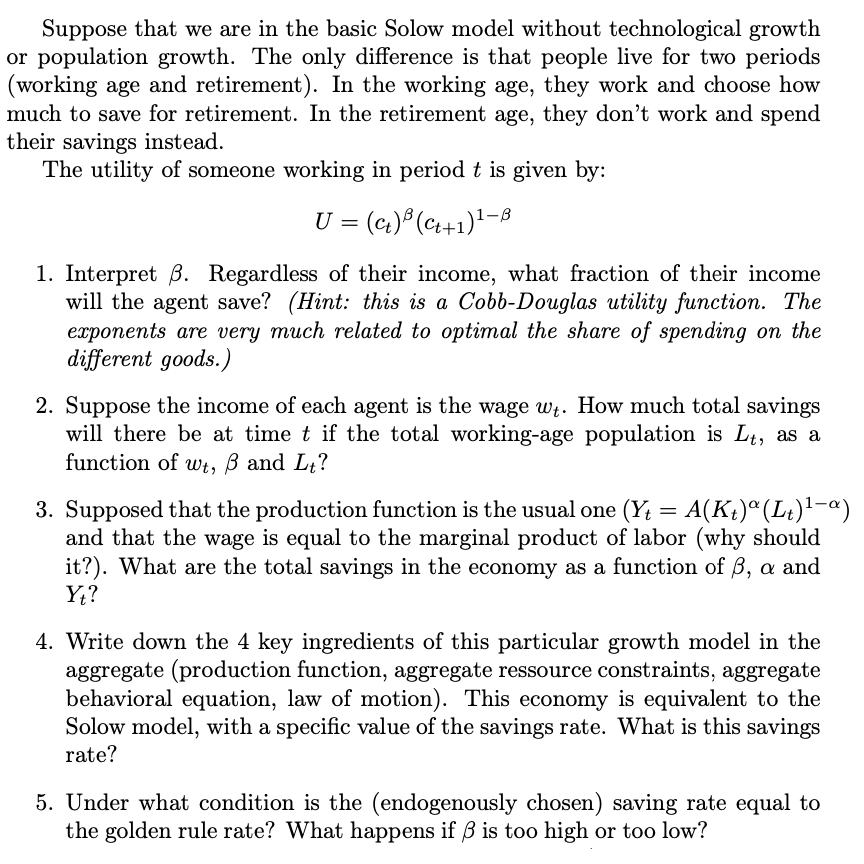Suppose that we are in the basic Solow model without technological growth or population growth. The only difference is that people live for two periods (working age and retirement). In the working age, they work and choose how much to save for retirement. In the retirement age, they don't work and spend their savings instead.
Suppose that we are in the basic Solow model without technological growth or population growth. The only difference is that people live for two periods (working age and retirement). In the working age, they work and choose how much to save for retirement. In the retirement age, they don't work and spend their savings instead.
Chapter1: Making Economics Decisions
Section: Chapter Questions
Problem 1QTC
Related questions
Question

Transcribed Image Text:Suppose that we are in the basic Solow model without technological growth
or population growth. The only difference is that people live for two periods
(working age and retirement). In the working age, they work and choose how
much to save for retirement. In the retirement age, they don't work and spend
their savings instead.
The utility of someone working in period t is given by:
U = (Ct) ³ (Ct+1)¹-B
1. Interpret 3. Regardless of their income, what fraction of their income
will the agent save? (Hint: this is a Cobb-Douglas utility function. The
exponents are very much related to optimal the share of spending on the
different goods.)
2. Suppose the income of each agent is the wage wt. How much total savings
will there be at time t if the total working-age population is Lt, as a
function of wt, B and Lt?
3. Supposed that the production function is the usual one (Yt = A(Kt) a (Lt) ¹-a)
and that the wage is equal to the marginal product of labor (why should
it?). What are the total savings in the economy as a function of B, a and
Yt?
4. Write down the 4 key ingredients of this particular growth model in the
aggregate (production function, aggregate ressource constraints, aggregate
behavioral equation, law of motion). This economy is equivalent to the
Solow model, with a specific value of the savings rate. What is this savings
rate?
5. Under what condition is the (endogenously chosen) saving rate equal to
the golden rule rate? What happens if 3 is too high or too low?
Expert Solution
This question has been solved!
Explore an expertly crafted, step-by-step solution for a thorough understanding of key concepts.
Step by step
Solved in 7 steps

Knowledge Booster
Learn more about
Need a deep-dive on the concept behind this application? Look no further. Learn more about this topic, economics and related others by exploring similar questions and additional content below.Recommended textbooks for you


Principles of Economics (12th Edition)
Economics
ISBN:
9780134078779
Author:
Karl E. Case, Ray C. Fair, Sharon E. Oster
Publisher:
PEARSON

Engineering Economy (17th Edition)
Economics
ISBN:
9780134870069
Author:
William G. Sullivan, Elin M. Wicks, C. Patrick Koelling
Publisher:
PEARSON


Principles of Economics (12th Edition)
Economics
ISBN:
9780134078779
Author:
Karl E. Case, Ray C. Fair, Sharon E. Oster
Publisher:
PEARSON

Engineering Economy (17th Edition)
Economics
ISBN:
9780134870069
Author:
William G. Sullivan, Elin M. Wicks, C. Patrick Koelling
Publisher:
PEARSON

Principles of Economics (MindTap Course List)
Economics
ISBN:
9781305585126
Author:
N. Gregory Mankiw
Publisher:
Cengage Learning

Managerial Economics: A Problem Solving Approach
Economics
ISBN:
9781337106665
Author:
Luke M. Froeb, Brian T. McCann, Michael R. Ward, Mike Shor
Publisher:
Cengage Learning

Managerial Economics & Business Strategy (Mcgraw-…
Economics
ISBN:
9781259290619
Author:
Michael Baye, Jeff Prince
Publisher:
McGraw-Hill Education